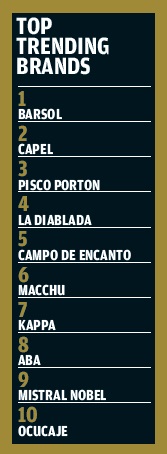Pisco has moved on from being just the principal ingredient of the Pisco Sour. Bartenders worldwide are now exploring the category – likely they’ve found it complicated.
There are the Peruvian styles, exports of which have been at the forefront of changing perceptions of pisco over the past 10 years, but they have always operated in low volumes. Then there’s the Chilean pisco, which tends to be larger volume, but has a growing band of craft producers that have set their sights on export markets.
Our list is made up of seven Peruvian piscos and three from Chile. Half of the bars polled only stocked one pisco, which shows you how far the category has to go. That one bottle, in at least a third of cases, says our poll, is Barsol. Founder Diego Loret de Mola, has been at the vanguard of craft pisco over recent years. His approach has been to find the right partners that can build his brand in the key bar markets, such as Anchor Distilling Company in the US and Speciality Brands in the UK. If our poll is anything to go by, it seems to be working.
In second place is Macchu pisco, a Peruvian single grape varietal, which was the poured pisco in 13% of polled bars. The family company, headed by Peruvian Melanie Da Trindade-Asher, also produces the seventh-ranked brand on our list, La Diablada, an aromatic style made from four grapes: quebranta, Italia, toratel and muscatel.
Campo De Encanto, which translates as Fields of Enchantment, is the work of San Francisco bar owner Duggan McDonnell, sommelier Walter Moore and distiller Carlos Romero. It is a blend of three grapes that are vinified, once-distilled and aged for nine months and is the house pisco at 12% of our polled bars.
The largest pisco brand and our first from Chile is Capel, which majors on double-distilled pisco, both white and oak-aged.
..............................................................................................................
Methodology
The Drinks International Annual Bar Report looks to gauge the buying habits of the best bars in the world by conducting a survey of their owners, head bartenders and bar managers.
The bars that took part – what we refer to as the best bars in the world – are a sample of 108 bars that finished in the top 250 places of the World’s 50 Best Bars survey, now owned by William Reed Business Media. Given the depth and scope of The World’s 50 Best Bars poll (voted for by 476 global bar experts) we feel this is the most credible place to source our sample of bars.
In each instance we asked the bartender to rank their three best selling products in each category, giving us an indication of the brands that are selling best.
As we know, a best selling brand, even in the best bars in the world, earns its place on more than taste, so we also wanted to know the brands that are not necessarily doing huge volumes but have cool-appeal right now. This is where the Trending brands come in. These are the brands customers are increasingly asking for, perhaps because of word of mouth, or even on bartenders’ recommendations.
For more on the methodology see How we did it



